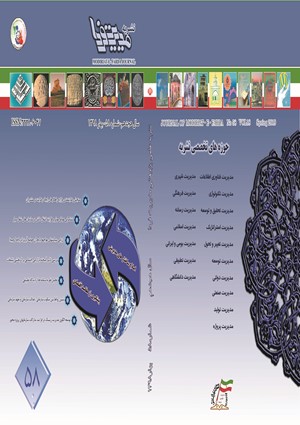شناسایی و الگوسازی عوامل مؤثر بر آمادگی الکترونیکی صنایع تولیدی جهت استقرار تولید الکترونیکی
محورهای موضوعی : مدیریت فناوری اطلاعاتکامران فیضی 1 , محمد تقی تقوی فرد 2 , جهانیار بامداد صوفی 3 , حسین وحیدی 4
1 - دانشگاه علامه طباطبائی
2 - دانشگاه علامه طباطبائی
3 - دانشگاه علامه طباطبائی
4 - مدیریت و حسابداری
چکیده مقاله :
در دنیای رقابتی امروز، توانایی پذیرش و بکارگیری فاوا در بخش صنعت یکی از عوامل کلیدی موفقیت در صنایع تولیدی میباشد. هدف از انجام این پژوهش شناسایی و الگوسازی عوامل موثر بر آمادگی الکترونیکی صنایع تولیدی جهت استقرار تولید الکترونیکی در آنها میباشد. پژوهش حاضر با استفاده از روش تحقیق آمیخته و در 3 مرحله صورت پذیرفته است. ابتدا از روش 7 مرحلهای فراترکیب بارو سو و سندلوسکی استفاده گردیده و مدل مفهومی اولیه تحقیق شکل گرفته است. سپس در مرحله دوم با انجام مصاحبههای نیمه ساختار یافته با خبرگان مدل تکمیلی تحقیق حاصل گردیده و در مرحله سوم به منظور اعتبار سنجی کمی الگوی پیشنهادی، از آزمونهای مختلف آماری و روش تحلیل عاملی تاییدی استفاده شده است. همچنین جهت بررسی صحت و سقم فرضیات و آزمون الگوی پیشنهادی از مدل سازی معادلات ساختاری و روش تحلیل مسیر توسط نرم افزار Smartpls3 بهره بردهایم. پس از تأیید مساعد بودن ضرایب مسیر و معنادار بودن ضرایب(t-value) به بررسی الگوی تحقیق بر اساس شاخصهای مختلف پرداخته ایم که نتیجه بررسی شاخصها نشان دهنده برازندگی الگوی پیشنهادی بود. پس از انجام مراحل فوق کفایت علمی الگوی پژوهش تایید گردید. بدین ترتیب الگوی تحقیق با 3 مؤلفه اصلی : زیر ساختهای فاوا در تولید ، ظرفیتهای بکارگیری فاوا در تولید ، فرصتهای ارزش افزای فاوا در تولید و با 28 شاخص(زیر مؤلفه) مورد تأیید نهایی قرار گرفت .
In today’s competitive world, the ability of acceptance and utilization of ICT in industries is one of the critical success factors in productive industries. The target of this paper is presentation of a model for evaluation of e-manufacturing e-readiness in manufacturing industries. This research was conducted in three phases utilizing mixed research method. In the first phase, Barroso and Sandelowski Meta-Synthesis method containing seven steps was invoked and the primary conceptual model was created. In the second phase, by arranging semi-structured interviews with the experts, a supplementary model was completed. In the third phase in order to quantitatively validate the developed model, various statistical tests and confirmatory factor analysis were employed. Structural equation modeling and path analysis were made use of for checking accuracy of the assumptions as well as testing the proposed model in SmartPLS 3 software. After confirmation of path coefficients and coefficients meaningfulness (t-values), we checked model in terms of various indexes, all of which point to the eminence of the model. The results of applying the above steps were corroboration of the scientific standing of the latter model. Incorporating there major components i.e. , ICT infrastructure in manufacturing , ICT application capacities in manufacturing, ICT value augmenting opportunities in manufacturing along with 28 indexes, the model set forth in this study was ultimately received full confirmation.
